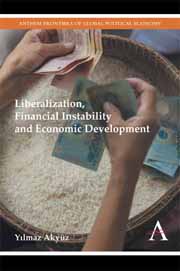Book contents
- Frontmatter
- Dedication
- Contents
- Introduction
- PART ONE LIBERALIZATION, STABILITY AND GROWTH
- Chapter I Financial Liberalization: The Key Issues
- Chapter II Managing Financial Instability in Emerging Markets: A Keynesian Perspective
- Chapter III From Liberalization to Investment and Jobs: Lost in Translation
- Chapter IV Exchange Rate Management, Growth and Stability: National and Regional Policy Options in Asia
- Chapter V Reforming the IMF: Back to the Drawing Board
- PART TWO THE GLOBAL ECONOMIC CRISIS AND DEVELOPING COUNTRIES
Chapter III - From Liberalization to Investment and Jobs: Lost in Translation
from PART ONE - LIBERALIZATION, STABILITY AND GROWTH
- Frontmatter
- Dedication
- Contents
- Introduction
- PART ONE LIBERALIZATION, STABILITY AND GROWTH
- Chapter I Financial Liberalization: The Key Issues
- Chapter II Managing Financial Instability in Emerging Markets: A Keynesian Perspective
- Chapter III From Liberalization to Investment and Jobs: Lost in Translation
- Chapter IV Exchange Rate Management, Growth and Stability: National and Regional Policy Options in Asia
- Chapter V Reforming the IMF: Back to the Drawing Board
- PART TWO THE GLOBAL ECONOMIC CRISIS AND DEVELOPING COUNTRIES
Summary
Global Economic Integration and the Labor Market
There is nothing so disastrous as a rational investment policy in an irrational world.
John Maynard KeynesThe past two decades have seen an increased global integration of labor markets to a degree unprecedented in recent history despite continued barriers to labor mobility, particularly for low-skilled and unskilled workers. This has been driven by a rapid opening to and expansion of international trade and capital flows, and a growing spread of global production networks, outsourcing and offshoring. The total number of workers producing for international markets in goods alone rose from around 300 million in 1980 to almost 800 million at the turn of the millennium. This has been associated with a significant increase in the share of developing countries in world trade in manufactures. Accordingly, about 90 percent of the labor participating in world trade is now low-skilled and unskilled (Akyüz 2003, 100–101). Integration of labor markets has also been reinforced by increased trade in services, traditionally seen as nontraded activities, particularly through expansion of cross-border supply of certain services from the territory of one country to the territory of another, and consumption and commercial presence abroad. Services trade has expanded not only in low-skill, low-value-added activities such as call centers or transaction processing, but also in high-value-added sectors that involve skilled labor, notably in information technology, finance and health. Developing countries have become suppliers of some of these services, including in high-value added sectors.
- Type
- Chapter
- Information
- Publisher: Anthem PressPrint publication year: 2014



